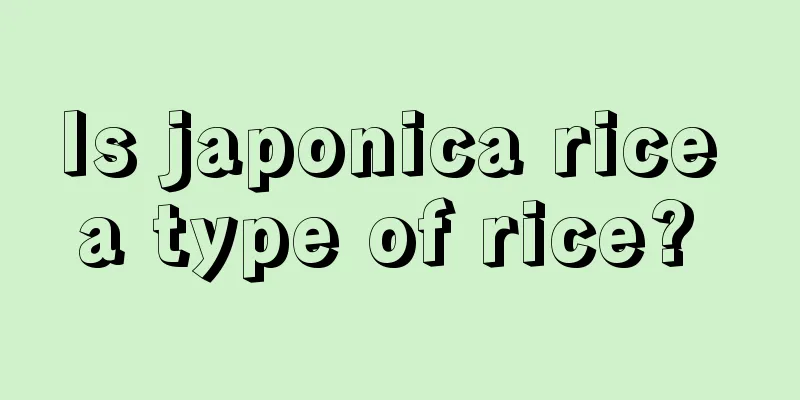Is japonica rice a type of rice?

|
What kind of rice is japonica rice? Many people lack life experience, especially some newlyweds. It is the first time they live outside the arms of their parents and they are not very experienced in choosing diet and daily necessities in life. They don't know much about japonica rice. So, is japonica rice the same as rice? Are there any differences between them? What are the benefits of eating japonica rice? Japonica rice is a type of rice Japonica rice is the staple food of people in southern my country. It contains a large amount of carbohydrates, accounting for about 79%, and is the main source of calories. Japonica rice is the kernel of japonica rice, also known as rice. It tastes sweet and mild, and has a mild nature. It is a nourishing food if eaten daily. Japonica rice is a type of rice that is cultivated throughout China with a cultivation history of more than 6,900 years. It is one of the specialties of Chinese food culture. It is mainly produced in North China, Northeast China and southern Jiangsu. The famous Xiaozhan rice and Shanghai white japonica rice are all high-quality japonica rice. It is rice made from non-glutinous japonica rice grains. Rice grains are generally oval or round. The rice grains are plump and thick, with a nearly round cross-section, a length-to-width ratio of less than two, a waxy white color, and are transparent or translucent. The texture is hard and tough, and after cooking it is sticky and oily, soft and delicious, but the rice yield is low. Japonica rice is divided into early japonica rice and late japonica rice according to the harvest season. Early japonica rice is translucent, has a larger white belly, fewer hard grains, and poorer rice quality. Late japonica rice is white or waxy white, has a small belly, many hard grains, and is of excellent quality. The yield of japonica rice is much lower than that of indica rice. Japonica rice is relatively thick and short, and the Cantonese people call it "fat boy rice". The porridge and rice cooked with it are relatively soft. The common Northeast rice, pearl rice, and Jiangsu round rice are all japonica rice. Rice is a finished product made from paddy rice after processes such as cleaning, husking, milling and finishing. The cleaning process is to use suitable equipment, appropriate process flow and proper operating methods to remove various impurities mixed in the rice to improve the quality of the finished rice. At the same time, magnets are used to remove iron nails, iron filings, etc. in the rice to ensure production safety. The rice hulling process is to use a rubber roller husker or a corundum husker to remove the husk of the rice and separate the husk from the brown rice. The rice milling process is to use a rice mill to grind and rub the brown rice to separate the cortex and endosperm, and then carry out processes such as brushing the rice, removing the bran, removing the broken pieces, and drying the rice, so that the required grade of rice can be obtained. Rice is divided into three categories: indica rice, japonica rice and glutinous rice. Indica rice is made from non-glutinous rice of the Indica type, and the rice grains are generally oblong or elongated. According to the harvest season of indica rice, it is divided into early indica rice and late indica rice. Japonica rice is made from japonica non-glutinous rice grains, and the rice grains are generally oval in shape. According to the harvest season of japonica rice, it is divided into early japonica rice and late japonica rice. Glutinous rice is made from glutinous rice. It is milky white, opaque, or translucent, and very sticky. It is divided into two types: indica glutinous rice and japonica glutinous rice. Indica glutinous rice is made from indica-type glutinous rice, and the rice grains are generally oblong or slender; japonica glutinous rice is made from japonica-type glutinous rice, and the rice grains are generally oval. If japonica rice is cooked, it will be very soft and tough, while rice will taste more elastic. Japonica rice can help people's gastrointestinal motility, prevent stomach problems and constipation, enhance the body's immunity and prevent high blood pressure. It can also prevent athlete's foot, provide the human body with a large amount of protein and vitamins, and lower cholesterol. |
<<: How does the human body improve its own immunity
>>: What should you pay attention to when swimming?
Recommend
Two proven prescriptions for treating esophageal cancer with traditional Chinese medicine
Esophageal cancer is classified as "dysphagi...
What to do if you feel sore all over after drinking
Most of us, in life, whether there is a happy eve...
Cost of draining ascites for liver cancer
I believe everyone knows that liver cancer is a v...
How to wash with orange juice
Have you ever had this experience: you are happil...
The correct way to polish leather shoes
After entering society, everyone will buy a pair ...
Does drinking honey water help you sleep?
Insomnia is very common in modern life. Due to th...
Never getting enough sleep? It turns out that he was suffering from several diseases
Some people love to sleep very much and always fe...
Success rate of frozen embryo transplantation
With the development of medical technology, relat...
What are the symptoms of keratitis
Keratitis is a common inflammation in clinical pr...
Principles of medication for bone cancer pain
Pain is one of the most common symptoms of bone c...
When is the best time to take iron supplements
Iron is an essential element in our lives. If you...
Common symptoms of advanced esophageal cancer
Esophageal cancer has no specific symptoms in the...
Why is my heart beating so fast?
When people are nervous, fearful, etc., their hea...
What are the effects of wisdom tooth extraction
If wisdom teeth do not grow in completely and pai...
What is the blood pressure? Is blood pressure low?
Recently, a large number of patients have been tr...









